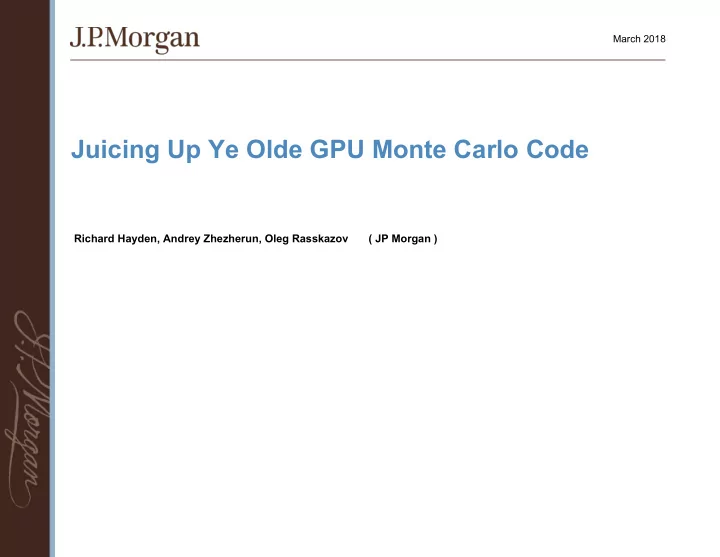

March 2018 Juicing Up Ye Olde GPU Monte Carlo Code Richard Hayden, Andrey Zhezherun, Oleg Rasskazov ( JP Morgan )
GPUs in JP Morgan ❑ JP Morgan has been using GPUs extensively to speed up risk calculations and reduce computational costs since 2011. ❑ Speedup as of 2011 ~ 40x ❑ Large Cross Asset Quant Library (C++, Cuda) ❑ Monte Carlo and PDEs ❑ GPU code ❑ Hand-written Cuda Kernels ❑ Thrust ❑ Auto-Generated Cuda Kernels 2
GPU Compute use cases ❑ Revolutionary Compute density within the node ❑ Machine Learning applications ❑ Reducing Cost of Compute ❑ Fastest End-to-End calculations (focus of the talk) ❑ Real-time risk ❑ Example: pricing multiple “similar” instruments ❑ Common Monte Carlo diffusion ❑ Large number of similar payoffs ❑ E.g. parameterised by ❑ Coupon terms ❑ Barrier level ❑ Basket components ❑ Maturity 3
Starting point ❑ K80 on x86 ❑ Throughput-oriented setup ❑ Multi-tenancy on GPU ❑ Single instrument pricing interface ❑ Excess precision ? (storage/calculations are predominantly in double) ❑ Large overheads on multiple instrument pricing ❑ Repeated computations* ❑ CPU setup code ❑ Random number generation (GPU) ❑ Diffusion (GPU) ❑ Payoff compilation ❑ CUDA API calls * 1. there are modelling questions around “global” diffusion and correlations * 2. computations do not always fully overlap 4
Target improvements ❑ K80 on x86 ❑ Throughput-oriented setup ❑ Multi-tenancy on GPU ❑ Single instrument pricing interface ❑ Excess precision ? (storage/calculations are predominantly in double) ❑ Large overheads on multiple instrument pricing ❑ Repeated computations* ❑ CPU setup code ❑ Random number generation (GPU) ❑ Diffusion (GPU) ❑ Payoff compilation ❑ CUDA API calls * 1. there are modelling questions around “global” diffusion and correlations * 2. computations do not always fully overlap 5
IBM Power 8+ with P100 GPUs ❑ Half of the server (one chip). From https://www.ibm.com/blogs/systems/ibm-power8-cpu-and-nvidia-pascal-gpu-speed-ahead-with-nvlink/ 6
IBM Power 9 ( AC922 ) with 4 V100 GPUs ❑ NVLink 2 ❑ 6 Bricks, ❑ 1 Brick = 25 GB/s each way, see ❑ CPU <-> GPU – 75 GB/s each way ; System – +85% over Power 8 Memory ❑ NVidia Volta V100 GPUs Power 9 ❑ Half of Power 9 in the picture CPU V100 GPU V100 GPU 7
Payoff pricing interface ❑ Example auto-call instrument priced on 500,000 different 5-asset baskets, 10k MC paths each ❑ ~20% instrument/model object creation ❑ ~50% payoff compilation (on-the-fly CUDA) ❑ ~25% diffusion and setup ❑ <1% doing actual payoff computation on GPU ❑ GPU only running kernels about 1.5% of that time ❑ Vectorised payoff pricing interface ❑ Create instruments/model once and share for all payoff computation ❑ Compile payoff once (exposing all required parameterisations) ❑ Setup and diffuse the entire universe of required assets up front 8
Vectorised payoff pricing interface – initial results ❑ From >300 hrs to <1 minute Pricing time (s) GPU time (s) API time (s) Intel Haswell/K40 318.0 - - IBM Power8/P100 62.5 41.7 50.6 IBM Power9/V100 36.5 14.7 21.4 ❑ Lots of time spent in CUDA API ( cudaMalloc , cudaFree ) ❑ Use custom block allocator: Pricing GPU time (s) API time (s) Speedup time (s) Power8/P100 57.0 41.7 43.0 1.10 Power9/V100 31.1 14.7 16.5 1.17 9
GPU utilisation is low ❑ Move extra code to GPU, reuse data structures Pricing GPU time (s) API time (s) Speedup time (s) Power8/P100 (57.0) 53.0 (41.7) 41.8 (43.0) 43.2 1.18 Power9/V100 (31.1) 26.2 (14.7) 14.7 (16.5) 16.6 1.39 10
Single precision ❑ Use single precision for intermediate storage, means more paths fit into GPU memory at a time => further reduction in associated CPU overhead Pricing time GPU time (s) API time (s) Speedup (s) Power8/P100 (53.0) 45.0 (41.8) 38.1 (43.2) 39.1 1.39 Power9/V100 (26.2) 19.6 (14.7) 12.8 (16.6) 14.1 1.86 ❑ Use single precision also for computation of intermediate values Pricing time GPU time (s) API time (s) Speedup (s) Power8/P100 35.7 29.1 30.1 1.75 Power9/V100 17.7 11.1 12.4 2.06 11
Unified memory ❑ Use host memory to store final prices, leveraging unified memory / NVLink to access directly from GPU ❑ This frees up GPU memory for computing more paths/parameterisations at a time, reducing associated CPU overhead Pricing time GPU time (s) API time (s) Speedup (s) Power8/P100 (35.7) 40.6 (29.1) 34.2 (30.1) 38.4 1.54 Power9/V100 (17.7) 15.8 (11.1) 10.5 (12.4) 15.7 2.31 ❑ Final speedup Power 9 / V100 vs production code (K80): 20x 12
Summary ❑ Speed up Power 9 V100 vs Production : 20x (code optimizations + hardware) ❑ New use cases and hardware advances require architecture rethinks ❑ Our code is predominantly memory bound ❑ V100 and NVLink2 help ❑ Selective single precision works for computations but benefits mostly memory throughput storage ❑ Much more work to do ❑ Restructure the code to eliminate CUDA API overheads ❑ Optimize kernels for V100 ❑ Use all 4 GPUs within the node ❑ ~ 30-50x vs. baseline feasible ??? ❑ Benchmarking against Intel architecture with V100 (no NVLink to CPU) 13
Recommend
More recommend